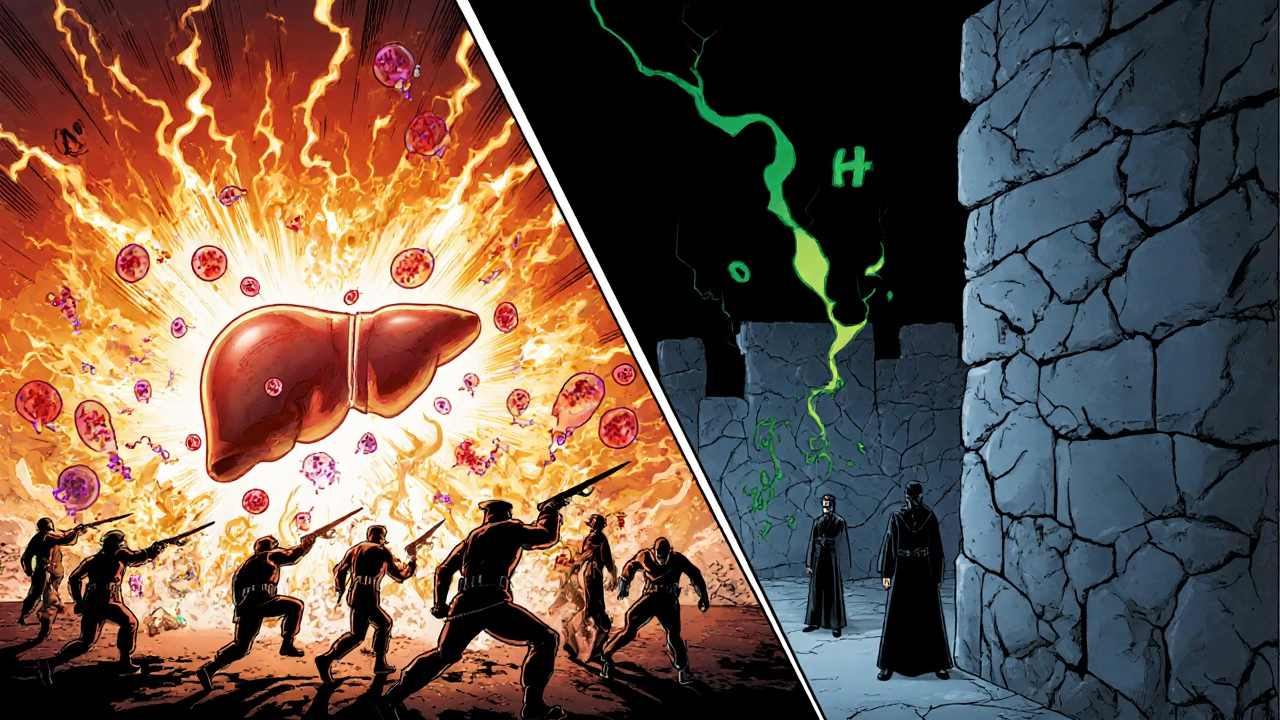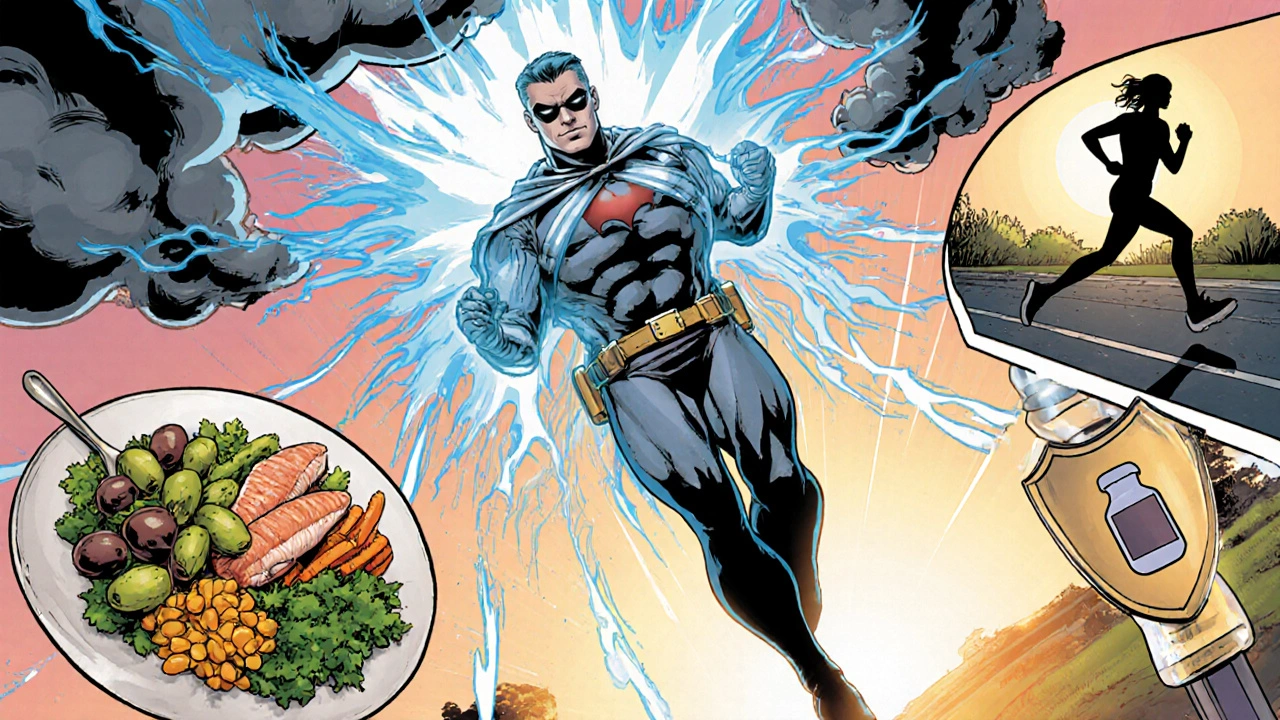Liver Failure Risk Calculator
This tool estimates your risk of liver failure based on factors discussed in the article. Enter your values to receive personalized insights.
Risk Assessment
Recommendations
When the liver starts to shut down, many people think it’s just a matter of toxins building up. In reality, the liver failure puzzle is tightly interwoven with the body’s immune defenses. Understanding how the immune system fuels, protects, or even worsens liver damage can change how patients are diagnosed, treated, and supported.
What Is Liver Failure?
Liver Failure is the inability of the liver to perform its essential functions, such as detoxification, protein synthesis, and bile production. It can arise suddenly (acute) or develop over years (chronic) and often leads to life‑threatening complications like encephalopathy, bleeding, and infection.
The condition is usually measured by blood markers (ALT, AST, bilirubin) and clinical signs (jaundice, ascites). While many causes exist-viral hepatitis, alcohol, drugs-immune‑driven damage is a major, yet under‑appreciated, player.
The Immune System in a Nutshell
Immune System is the network of cells, tissues, and molecules that defend the body against pathogens and maintain internal balance. It consists of innate components (e.g., macrophages, complement) that act fast, and adaptive components (T‑cells, B‑cells) that provide targeted, long‑lasting responses.
When the liver is healthy, it works hand‑in‑hand with the immune system, filtering blood, removing bacterial products, and tolerating harmless antigens from food. Disruption of this partnership can swing the pendulum toward inflammation or immune suppression.
How the Immune System Interacts With the Liver
The liver is a frontline immune organ. Blood from the gut, rich in nutrients and microbial fragments, passes through the hepatic portal vein before reaching the systemic circulation. This unique positioning means the liver constantly samples antigens and decides whether to trigger an immune response.
Key processes include:
- Antigen presentation by liver sinusoidal endothelial cells and Kupffer cells.
- Production of cytokines that shape systemic inflammation.
- Induction of immune tolerance through regulatory T‑cells, preventing over‑reaction to harmless substances.
When these mechanisms go awry, the immune system can become a double‑edged sword-either failing to clear infections or launching an attack that destroys hepatocytes, the liver’s main functional cells.

Key Immunological Players in Liver Failure
Several cell types and molecules act as the bridge between liver injury and immune dysregulation. Below are the most influential ones:
- Hepatocytes: The primary liver cells that metabolize drugs and produce proteins. Damage releases damage‑associated molecular patterns (DAMPs) that alert immune cells.
- Kupffer Cells: Resident macrophages that clear debris and secrete cytokines such as TNF‑α and IL‑6. Over‑activation leads to a cytokine storm.
- Cytokines: Signalling proteins (e.g., IL‑1β, IL‑10, IFN‑γ) that modulate inflammation. Imbalanced cytokine profiles are hallmarks of both acute and chronic liver failure.
- Autoimmune Hepatitis: A condition where the adaptive immune system mistakenly attacks hepatocytes, often leading to rapid deterioration.
- Sepsis: Systemic infection that triggers widespread immune activation. The liver’s detoxifying capacity is overwhelmed, accelerating failure.
Acute vs. Chronic Liver Failure: Immune Differences
| Feature | Acute Liver Failure (ALF) | Chronic Liver Disease (CLD) / Cirrhosis |
|---|---|---|
| Trigger | Drug toxicity, viral hepatitis, ischemia | Alcohol, chronic viral hepatitis, NAFLD, autoimmune |
| Immune Cell Dominance | Massive neutrophil and Kupffer cell activation | Persistent T‑cell infiltration and regulatory T‑cell imbalance |
| Cytokine Storm | High TNF‑α, IL‑6, IL‑1β within hours | Low‑grade elevation of IL‑10, TGF‑β leading to fibrosis |
| Complement Activation | Acute C5a surge → vascular leakage | Chronic low‑level C3 activation, contributes to portal hypertension |
| Clinical Consequence | Rapid encephalopathy, coagulopathy, multi‑organ failure | Progressive ascites, variceal bleeding, hepatic encephalopathy over years |
The table shows that while both forms involve immune mechanisms, the speed, intensity, and downstream effects differ dramatically. Recognizing these patterns helps clinicians choose the right immunomodulatory therapy.

Clinical Implications: Diagnosis, Treatment, and Monitoring
Because immune activity drives many complications, doctors now incorporate immunological tests alongside traditional liver panels. Common tools include:
- Serum cytokine panels (e.g., IL‑6, TNF‑α) to gauge inflammation.
- Flow cytometry for T‑cell subsets, especially regulatory vs. effector ratios.
- Liver biopsy with immunohistochemistry for Kupffer cell markers (CD68) and fibrosis (α‑SMA).
Therapeutic strategies targeting the immune system are evolving:
- Corticosteroids: Still first‑line for autoimmune hepatitis; they blunt T‑cell activation.
- Biologic agents: Anti‑TNF drugs (e.g., infliximab) have shown promise in severe ALF, but infection risk must be weighed.
- Plasma exchange: Removes circulating cytokines and DAMPs, buying time for liver regeneration or transplant.
- Immunonutrition: Supplementing omega‑3 fatty acids, vitamin D, and glutathione supports both liver cells and immune regulation.
For patients awaiting transplantation, modulating the immune response can reduce the chance of rejection and improve post‑operative recovery.
Lifestyle Tips to Support Both Liver and Immune Health
Even without a medical diagnosis, habits that nurture the liver also keep the immune system in check. Here are evidence‑based recommendations:
- Balanced diet: Emphasize plant‑based proteins, whole grains, and antioxidants (berries, leafy greens). Studies in 2024 link Mediterranean‑style eating to lower serum IL‑6 levels.
- Limit alcohol: Keep intake under 14g per day for women, 28g for men. Alcohol directly impairs Kupffer cell function.
- Stay hydrated: Adequate water aids bile flow and toxin clearance.
- Regular moderate exercise: 150minutes/week of brisk walking reduces hepatic fat and normalizes peripheral immune cell counts.
- Vaccinations: Hepatitis A and B vaccines prevent viral triggers that can spark immune‑mediated liver injury.
- Manage stress: Chronic cortisol elevation skews cytokine production toward a pro‑inflammatory profile.
Combining these lifestyle steps with medical oversight can slow disease progression and improve quality of life.
Frequently Asked Questions
Can the immune system cause liver failure on its own?
Yes. Autoimmune hepatitis and severe systemic infections (sepsis) can trigger immune‑mediated destruction of hepatocytes, leading directly to acute liver failure when unchecked.
What blood tests reveal immune involvement in liver disease?
Beyond ALT/AST, clinicians often order CRP, ferritin, IL‑6, TNF‑α, and detailed lymphocyte panels (CD4/CD8 ratios). Elevated cytokines usually signal active inflammation.
Is a liver transplant the only cure for immune‑driven failure?
Not always. Early immunosuppression, plasma exchange, or targeted biologics can reverse damage in some acute cases. Transplant remains essential for end‑stage chronic disease.
How does alcohol affect the liver‑immune relationship?
Alcohol impairs Kupffer cell phagocytosis and shifts cytokine production toward pro‑inflammatory TNF‑α, amplifying tissue injury and reducing the organ’s tolerance capacity.
Can diet alone modulate the immune response in liver patients?
Diet can tilt the balance. Omega‑3 fatty acids, for example, suppress NF‑κB signaling, lowering IL‑6 and TNF‑α levels. While not a substitute for medication, nutrition is a powerful adjunct.
Understanding the dance between the immune system and liver function turns a scary diagnosis into a manageable condition. By watching the signs, using targeted tests, and applying both medical and lifestyle interventions, patients and clinicians can steer the outcome toward recovery.







Comments
Valerie Vanderghote
October 17, 2025 AT 02:36 AMIt’s fascinating how the liver, this unassuming organ tucked away behind the ribs, actually moonlights as an immunological sentry, constantly sampling the gut’s endless parade of microbial fragments, food antigens, and occasional toxins; when that delicate balance tips, the ensuing cascade feels like a slow‑motion avalanche of cytokine storms, DAMP release, and Kupffer cell over‑activation, which in turn drags the entire system into a state of chronic inflammation that seems to gnaw at every cell’s optimism.
One can picture the liver as a weary gatekeeper, its sinusoidal endothelial cells whispering “stay out” to harmful agents while simultaneously extending a gentle hand to harmless dietary proteins, a duality that, when disrupted, mirrors the inner turmoil of a person torn between duty and desire.
The article’s breakdown of acute versus chronic immune profiles reminded me of the difference between a sudden thunderclap and a prolonged drizzle, each with its own signature cytokines-TNF‑α, IL‑6, and IL‑1β for the former, IL‑10 and TGF‑β for the latter-yet both eventually converge on the same grim endpoint if left unchecked.
What truly struck a chord with me was the notion that even seemingly benign lifestyle choices, like a modest daily glass of wine, can tip the scales by altering Kupffer cell phagocytic efficiency, subtly nudging the immune system toward a pro‑inflammatory stance.
Moreover, the interplay between regulatory T‑cells and hepatic tolerance feels almost poetic, as if the body’s own peacekeepers are trying desperately to negotiate a cease‑fire amidst a battlefield of over‑zealous immune warriors.
I can’t help but imagine the patient’s perspective, grappling with the bewildering array of lab values-ALT, AST, bilirubin, cytokine panels-each number a cryptic clue in a larger mystery that only a multidisciplinary team can hope to solve.
The discussion of plasma exchange also opened a window into how we might temporarily “reset” the immune milieu, flushing away the toxic DAMPs and cytokines that act like relentless alarms screaming for attention.
In the same vein, the emphasis on omega‑3 fatty acids and vitamin D as immunonutrients paints a hopeful picture where diet is not just sustenance but a strategic weapon in the fight against hepatic decline.
It’s also worth noting that the article subtly hints at the future of personalized medicine, where flow cytometry could one day tailor immunosuppressive regimens to an individual’s unique T‑cell repertoire, thereby minimizing collateral damage.
Even the brief mention of the complement system’s dual role-C5a’s acute surge versus chronic C3 activation-underscores the fine line between protective surveillance and pathological destruction.
While the piece is rich in technical detail, it never loses sight of the human element, reminding us that behind every laboratory value is a person yearning for recovery, for family meals, for the simple pleasure of feeling well again.
The integration of lifestyle recommendations, such as regular moderate exercise and stress management, serves as a gentle reminder that medicine is not confined to the clinic but lives in the daily rhythms of our lives.
All these facets together illustrate a complex, interwoven tapestry where liver health and immune function are inseparable partners in the dance of life.
In the end, the article offers not just a scientific overview but a call to action for clinicians, researchers, and patients alike to recognize and respect the critical connection that defines our very survival.
Michael Dalrymple
October 17, 2025 AT 05:43 AMReading this piece, one is reminded that the liver and immune system form a symbiotic partnership akin to the relationship between mind and body in philosophical thought. The delicate balance of pro‑inflammatory and anti‑inflammatory signals mirrors the dialectic of thesis and antithesis, ultimately leading to a synthesis of health. It is commendable how the authors have highlighted both cellular and molecular mechanisms, offering a comprehensive picture. Such integrative understanding should guide our therapeutic strategies, encouraging the use of targeted immunomodulation alongside supportive care. Ultimately, appreciating this connection empowers clinicians to intervene more precisely, fostering better outcomes for patients.
Richard O'Callaghan
October 17, 2025 AT 08:46 AMi gotta say this stuff about kupffer cells is kinda weird im not a doc but i feel like they should be in everyones brain they just chill in the liver like weird houseguests and when they get riled up they start sending out cytokines like crazy its like when you get bored at a party and start yelling at the music
Alexis Howard
October 17, 2025 AT 11:50 AMthey make a big deal about immune response but honestly most of it is overhyped minimal punctuation no need to dramatize
Darryl Gates
October 17, 2025 AT 14:53 PMGreat overview! I especially like the practical tips on diet and exercise – they’re simple, evidence‑based steps that patients can start today. Also, the explanation of cytokine storms was clear without being overly technical. Keep up the solid work.
Kevin Adams
October 17, 2025 AT 17:56 PMWow!!! This article is a rollercoaster of scientific wonder!!! The liver as a watchdog, cytokines raging like firestorms, and the immune system dancing a delicate tango!!! It feels like reading a dramatic saga where every cell is a hero or a villain!!! The tables, the bullet points – they paint a vivid picture of microscopic warfare!!! And those lifestyle tips? Pure golden nuggets!!! Keep the drama coming!!!
Joanna Mensch
October 17, 2025 AT 21:00 PMOne can't ignore the shadowy influence of big pharma in shaping how we view liver disease – the focus on immunomodulators feels like a profit‑driven agenda. Even the mention of omega‑3 supplements conveniently aligns with supplement manufacturers' marketing. It's worth staying skeptical about the motives behind some of these recommendations.
RJ Samuel
October 18, 2025 AT 00:03 AMAlright, let me sprinkle some color on this technical stew: imagine the liver as a bustling marketplace, each immune cell a quirky vendor hawking cytokines, some selling peace, others peddling chaos. When the market gets rowdy, you get that dreaded cytokine storm – quite the spectacle! But fear not, a dash of Mediterranean fare and a stroll in the park can tame even the most unruly merchants.
Nickolas Mark Ewald
October 18, 2025 AT 03:06 AMThis summary is clear and helpful. It covers the main points without unnecessary jargon. Thanks for the concise information.
Sara Werb
October 18, 2025 AT 06:10 AMHonestly, this whole “immune system helps” narrative is just another excuse for the global elites to push their patented drugs!!! The liver is being hijacked by pharma puppets, and they want us to believe that supplementing with omega‑3s will save us while they line their pockets!! The truth is hidden, and we must stay vigilant!!
Winston Bar
October 18, 2025 AT 09:13 AMyeah another boring pharma push, they always make it sound like a miracle cure but it’s just more money for them
Russell Abelido
October 18, 2025 AT 12:16 PMI hear the frustration, and it’s valid 😊. While skepticism is healthy, we can also recognize that some of the immunonutrition strategies do have solid research backing them. Balancing critical thinking with openness to evidence can help us navigate the noise.
Steve Holmes
October 18, 2025 AT 15:20 PMInteresting points all around! I’m curious about how often plasma exchange actually changes outcomes in acute liver failure. Any data on long‑term survival rates would be helpful.
Tom Green
October 18, 2025 AT 18:23 PMLet’s remember that every patient is unique, and while the science provides a framework, clinicians should tailor interventions to individual needs. Encouraging a collaborative approach between hepatologists, immunologists, and nutritionists can lead to more holistic care.
Rebecca Mitchell
October 18, 2025 AT 21:26 PMthe article jumps around a lot and could use a clearer structure
Patricia Echegaray
October 19, 2025 AT 00:30 AMThey’re hiding the cure.
Miriam Rahel
October 19, 2025 AT 03:33 AMThe exposition delineates the hepatic‑immune nexus with commendable thoroughness, yet it would benefit from a more nuanced discussion of the recent advancements in single‑cell transcriptomics that elucidate Kupffer cell heterogeneity. Moreover, integrating meta‑analyses of cytokine‑targeted therapies could furnish clinicians with actionable insights. In sum, while the review is comprehensive, augmenting it with cutting‑edge data would elevate its scholarly impact.